
CRU SPIRIT
Seniors Emily Huynh, Brock Pfrommer and Michaela Adcox proudly represent the Cru as they prepare to graduate this spring.



Seniors Emily Huynh, Brock Pfrommer and Michaela Adcox proudly represent the Cru as they prepare to graduate this spring.

SPRING 2025 | VOLUME 45, NUMBER 2
PRESIDENT Randy O’Rear, Ed.D. ’88
EDITOR-IN-CHIEF
Rebecca O'Banion, Ed.D. ’93
EDITOR
Christi Mays
CREATIVE DIRECTOR
Lauren Mendias
PHOTOGRAPHER
Hannah Van Beusekom
CONTRIBUTORS
Michaela Adcox Cru Athletics
India Dunn ’21 Jillian Hernandez
Ashley Smith ’03 Jennifer Jones ’08
Jeff Sutton ’07 Randy Yandell '99
Lauren Spears ’24 Riley Zayas
UMHB LIFE IS PUBLISHED THREE TIMES A YEAR BY THE MARKETING AND COMMUNICATIONS DEPARTMENT.
UMHB Box 8431
900 College Street Belton, Texas 76513
1-800-727-UMHB go.umhb.edu/life
Please send any change of personal information to: Alumni Engagement
UMHB Box 8427
900 College Street Belton, Texas 76513
Letters and comments can be sent to: umhblife@umhb.edu Or update online: umhb.edu/alumni alumni@umhb.edu

SPRING 2025 | VOLUME 45, NUMBER 2
02 | CAMPUS LIFE
In celebration of this year’s 180th anniversary, we take a comparative view at how things on campus looked way back when and how they look now.
04 | CAMPUS LIFE
Former Texas Gov. Rick Perry was welcomed as the 20th McLane Lecture speaker.
Women’s Cross Country team wins ASC title.
26 | ALUMNI NOTES
Alumna Barbara Austin ’07 discovers love of journaling, bringing her closer to God’s word.
ARCTIC ADVENTURE | 06
Art Department Chair Stephanie Chambers shares her magical voyage to paint near the North Pole.
AMAZING ATHLETES | 10
Two athletes tenaciously overcome barriers to pursue the sports they love.
CREATING A CULTURE OF BELONGING | 14
As UMHB reaches a milestone with 25 percent Hispanic enrollment, UMHB continues to help every student feel ownership and belonging.
MISSING HOME | 18
Two students discover timeless treasures to help them overcome homesickness.
WORKING TOGETHER | 22
Real-life ‘interprofessional’ scenarios help teach students how to work with other professions.
The Class of 1895 poses in front of Luther Hall, showing the powerful juxtaposition of yesterday and today as Luther Memorial stands as a testament to the enduring legacy of UMHB. PHOTO BY Randy Yandell '99


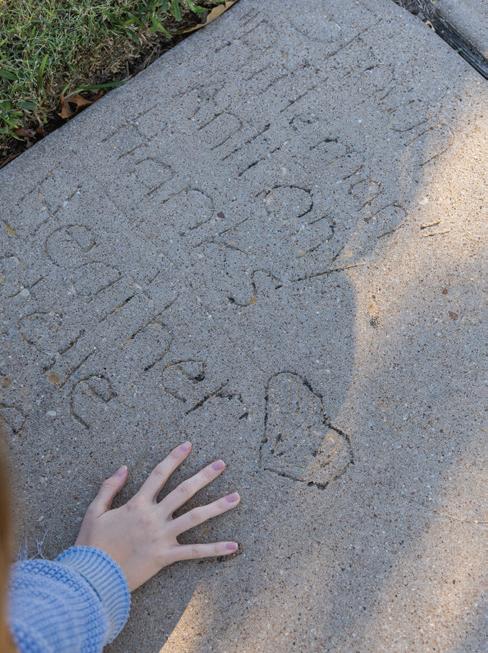



look vastly different from when UMHB started as an all-female college, but the mission to provide a Christian education remains steadfast.
One of the earliest aerial photos of campus, taken in 1929, shows a quaint campus with only a handful of buildings. Fast-forward and today’s landscape shows a vastly different scene, with new facilities sprouting up each year on the 340-acre campus. Even though UMHB has grown over the last 180 years, its essence and purpose remain unchanged.






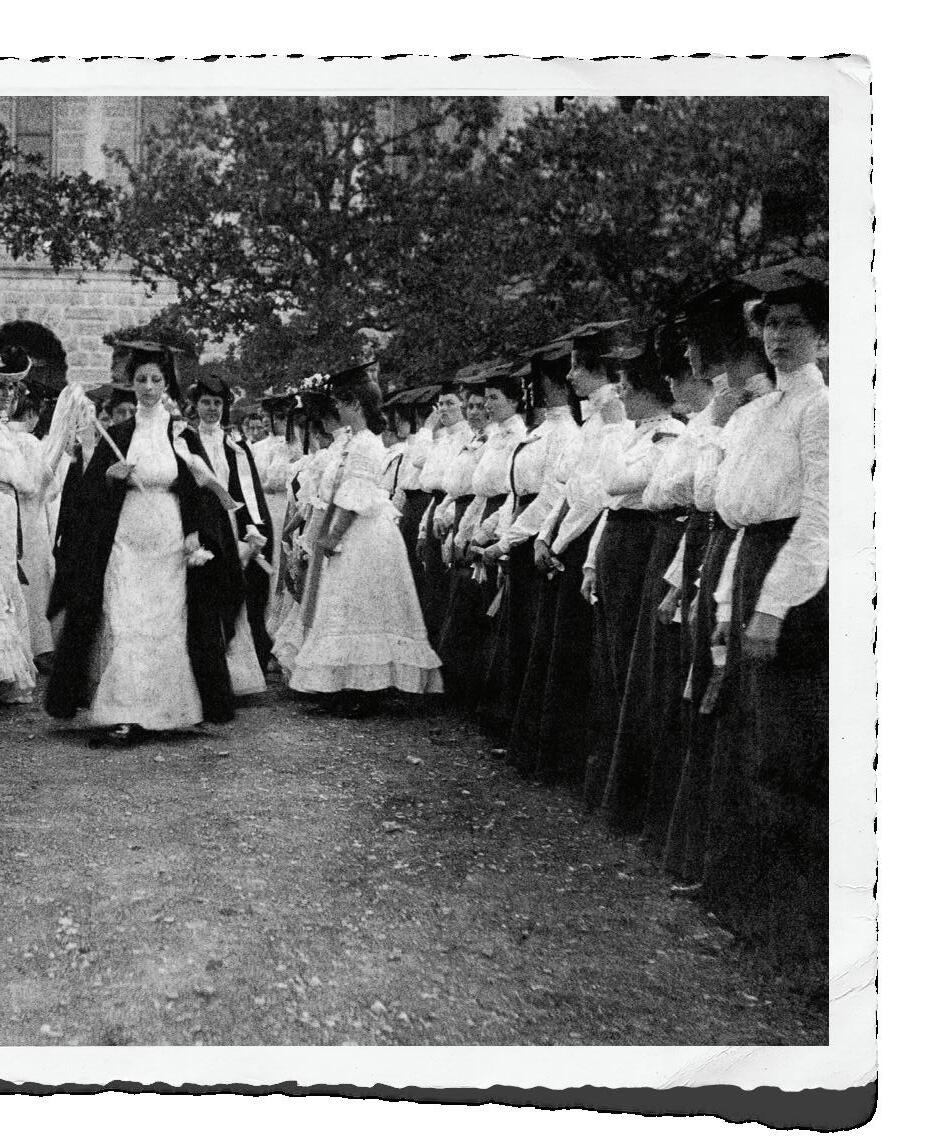


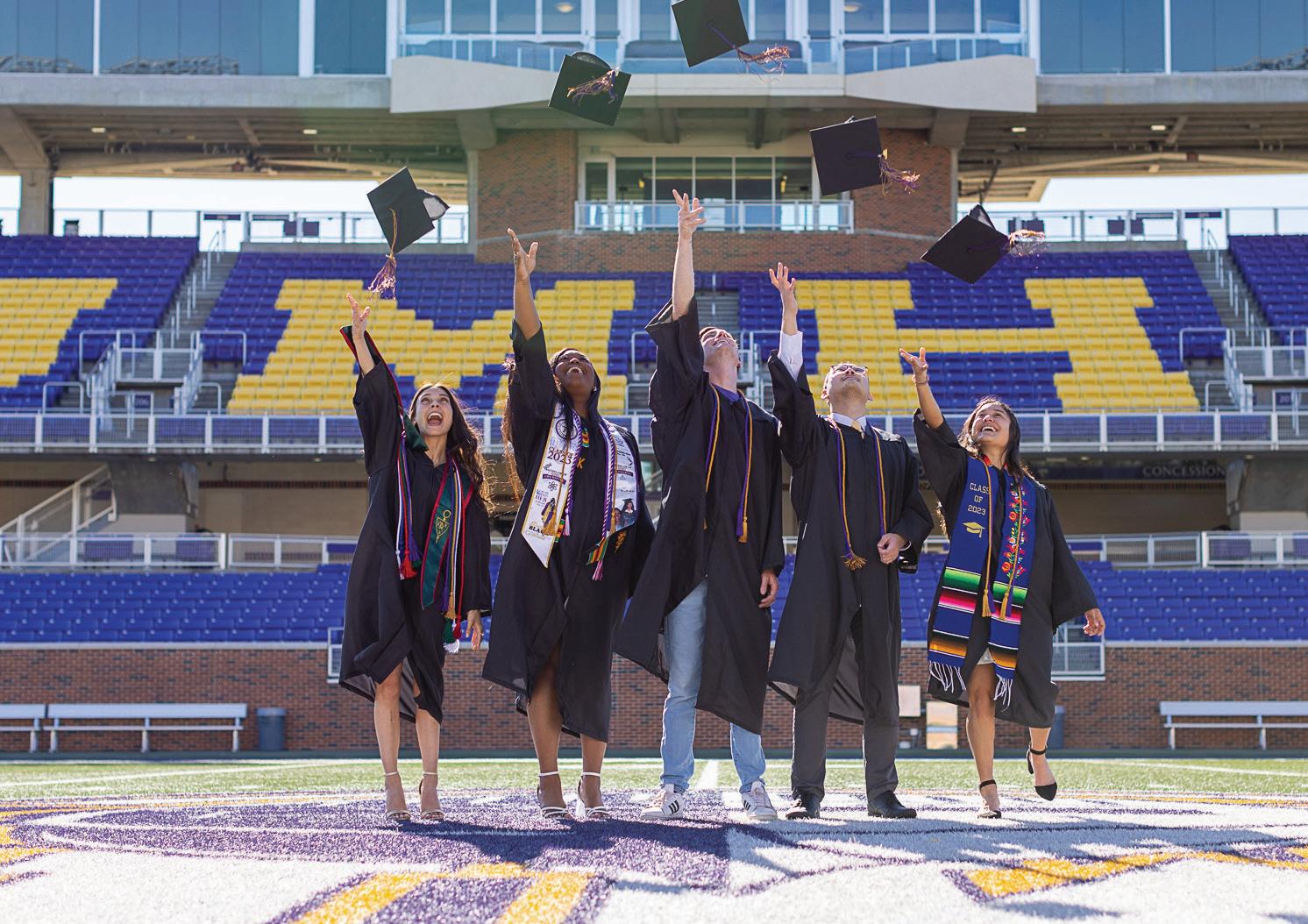


Since UMHB opened its doors in 1845, it has seen a significant evolution in technology in the classroom. From blackboards and chalk in the 1800s to typewriters and film in the mid-20th century to laptops and online learning in the last couple of decades.
The regalia and rituals of graduation ceremonies have changed over the years, as well as grown from a handful of graduates in the first classes to around 900 graduates each year.
Organized athletic activities were minimal in the early days of UMHB, with a primary focus on academic education and a mix of informal recreational activities, like archery, horseback riding and tennis. The last few decades have seen the university invest in facilities, coaching staff and recruitment to build nationally recognized sports programs that have earned numerous championships and accolades.
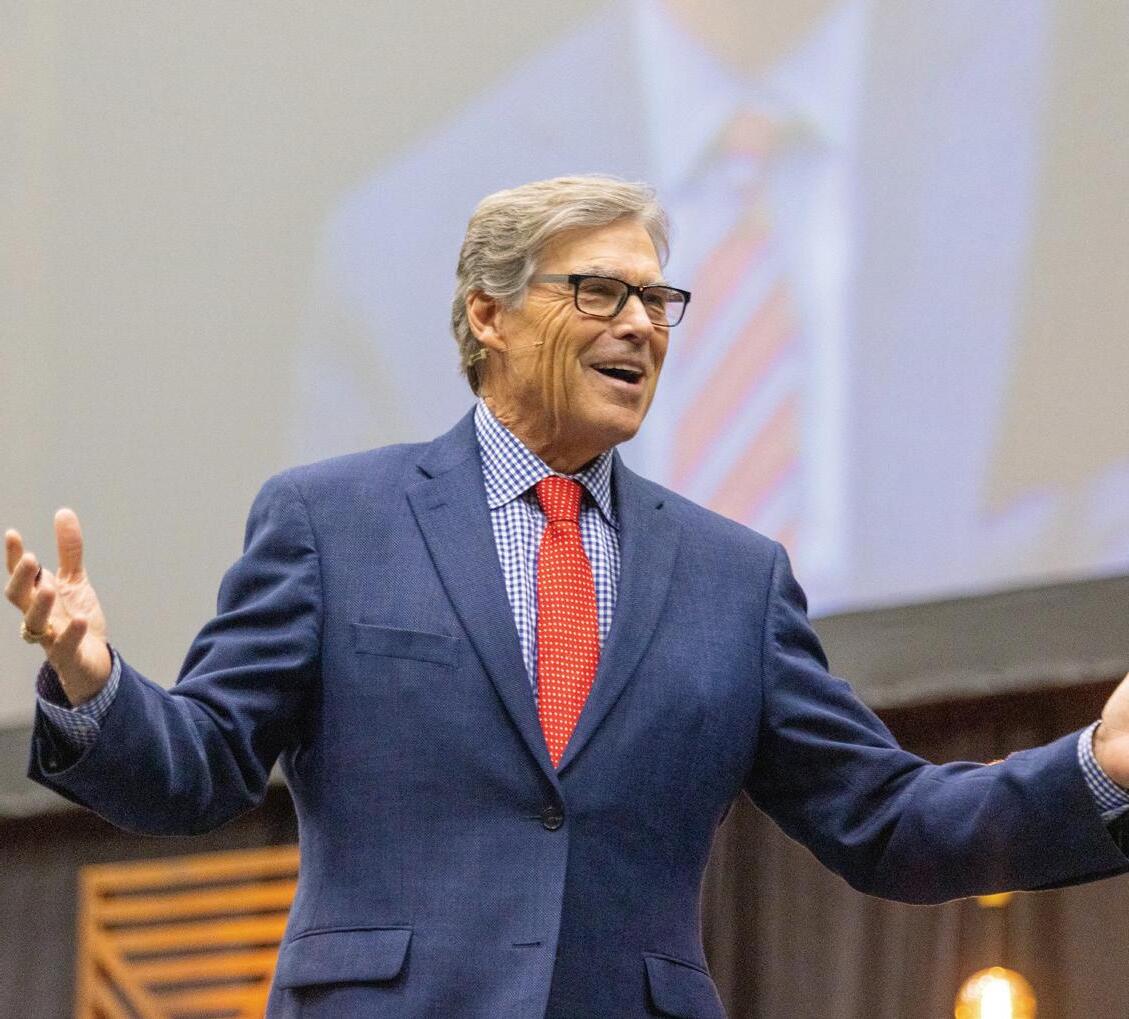


UMHB was honored to welcome former Texas Gov. Rick Perry as the featured speaker for the 2024 McLane Lecture on Nov. 6 in the Frank and Sue Mayborn Campus Center arena. The namesakes of the long-running lecture series, Elizabeth and Drayton McLane Jr., were also awarded Honorary Doctorate of Humanities degrees for their long-time friendship and commitment to Christian higher education at UMHB.
Perry is a born-and-bred Texan who served as the 14th U.S. Secretary of Energy and the 47th Governor of Texas. A veteran of the U.S. Air Force and a graduate of Texas A&M University, he championed conservative pro-growth principles that made Texas the world's 12th largest economy and the economic envy of America while serving as governor. Under his leadership as the Secretary of Energy, the nation ushered in a historic energy era. Throughout his career, he has supported both the active duty and veteran community, most recently as an advocate for using artificial intelligence to deliver
precision health care to warriors. He married his childhood sweetheart, Anita, in 1982, and they have two children, two granddaughters and two grandsons.
Perry spoke to the crowd of UMHB students, faculty, staff and special guests about his faith and life in public service.
"In 1964, I gave my life to Jesus Christ. At 14, the Holy Spirit dealt with me, and I had that warming of my heart," he said.
Perry urged students to seek God’s will and use the Bible as their compass.
"After becoming a pilot in the U.S. Navy, it became abundantly clear to me that the checklist I'd been given as a young man–the Holy Bible–will show you how to govern and conduct your business. Whether you're in the business world, a government leader or the head of your household, it will literally and figuratively save your life."
He went on to add that, "God has things He wants you to do. He wants you to live a life of purpose. If you trust Him, He has things much greater than you thought you could or would do. If you
will read His word and use His checklist, He'll guide you through life in a good way."
Before the lecture began, UMHB President Dr. Randy O'Rear presented Elizabeth and Drayton McLane Jr. with their Honorary Doctorate degrees.
"Elizabeth and Drayton are tremendous champions of UMHB and Christian higher education," O'Rear said. "Both are great friends and are worthy of receiving the highest honor from our university. The impact they have made on our students and campus is truly immeasurable."
Elizabeth and Drayton are well known for their successful businesses, commitment to community organizations and generous philanthropic activities. The McLane family's success is based on their commitment to high standards, innovation and customer service. Their dedication to strong Christian values, handed down from generation to generation, is reflected in the honesty and integrity that are the hallmarks of the family's businesses.

The Cru women's cross country team finished first in the November American Southwest Conference Championship race, winning the 2024 ASC Women's Cross Country Championship. UMHB won the title with an average time of 25:08 in the 6K race, which is roughly 3.73 miles.
Senior clinical psychology major Presley Wall finished in second place individually with a time of 23:44. The team went on to compete at the NCAA DIII West Regionals race in Estacada, Ore., where Presley was the Cru's top finisher with a time of 23:36.
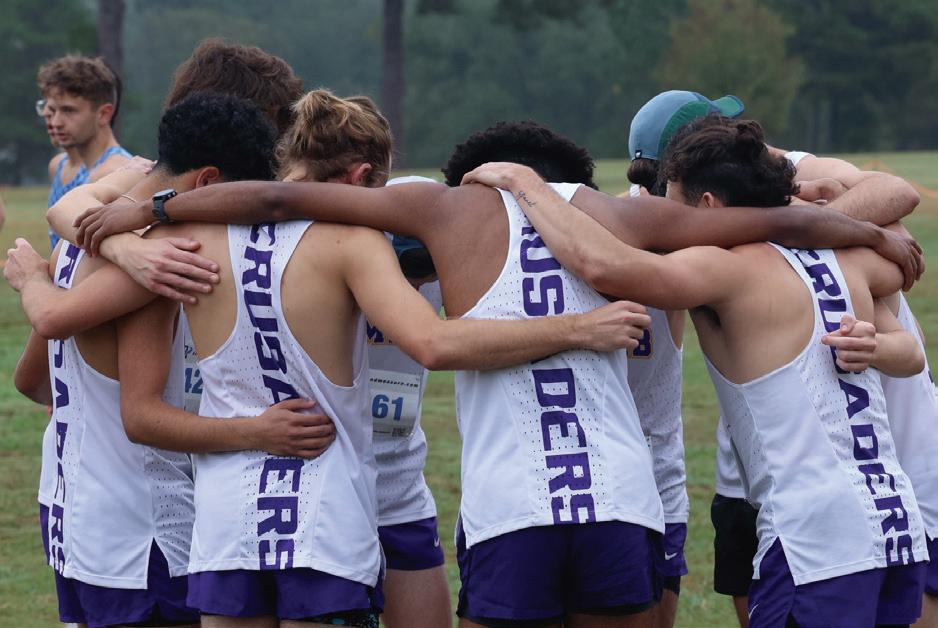
The UMHB men's cross country team finished second in the American Southwest Conference Championship with an average team time of 28.50 in the 8K run, which is roughly 4.97 miles. It was the highest finish in program history.
Junior pre-med major Andrew Young was the top Cru finisher in the championship race, earning seventh place overall with a time of 28:12. He and his brother, freshman Joshua Young, both from Tokay, Calif., qualified to compete individually at the NCAA DIII West Regionals race in Estacada, Ore.
The Cru football team fought hard this season, advancing to the NCAA Division III Quarterfinals against Johns Hopkins University with a final score of 10-17. The quarterfinal finish was the Cru's sixth in program history. UMHB went 3-1 in the 2024 playoffs with all four games played on the road.
UMHB volleyball closed out the season with a secondplace finish in the American Southwest Conference Championship game against East Texas Baptist University. The Cru finished with a 22-8 overall record and a 5-4 mark in conference play.

A mere 10 degrees latitude from the North Pole, aboard a tall ship sailing vessel, Art Department Chair Stephanie Chambers left behind the familiar comfort of civilization this past October on a transformative voyage to one of the most untouched corners of the world in the Arctic Circle. Her mission while on the expedition was to document and convey what she saw and felt through her medium of choice, paint. The trip turned out to be so much more than merely capturing scenes of snowy mountaintops and icy tundra, however. The trip was about capturing the feeling and essence of being present in such a remote and sublime area of the world, and it left her with a humbling sense of awe.
"It's a place so far removed from our everyday life, especially living here in Texas," she said. "Being above the
Arctic Circle is so dreamlike and such a surreal experience. We have no way to understand what that is or to be able to comprehend that type of environment. My project was to go and document it and bring back the experience and be able to share it in multiple venues, like in a gallery or giving talks—to bring awareness that this does exist and share it so it's not as far removed from everyday life so we can learn to protect it."
The experience was part of a 21-day trip that took Chambers to 80 degrees north latitude, where she was one of 30 international artists and scientists selected through the Arctic Circle Program to participate in a twoweek residency aboard the tall ship Antiqua sailing around the high Arctic to study and record the melting glaciers
Art Department Chair Stephanie Chambers works on her first painting on her expedition to the North Pole. Here, she is painting on Brenningsøya Island looking onto Esmarkbreen Glacier. She was so captivated by the scenery and painting that she didn’t notice the tide rising until she was six inches deep in water.
Photos by Becky Moseman

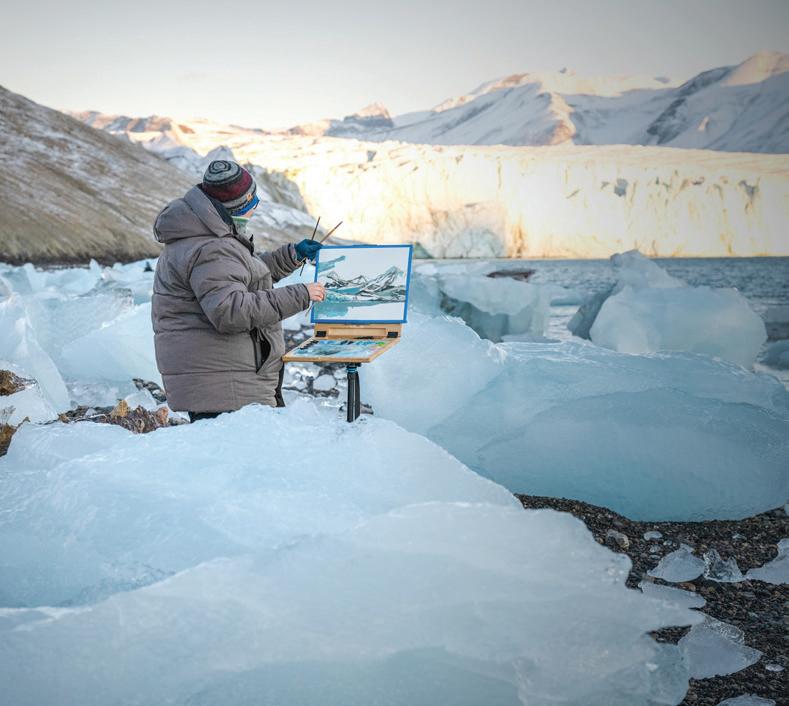
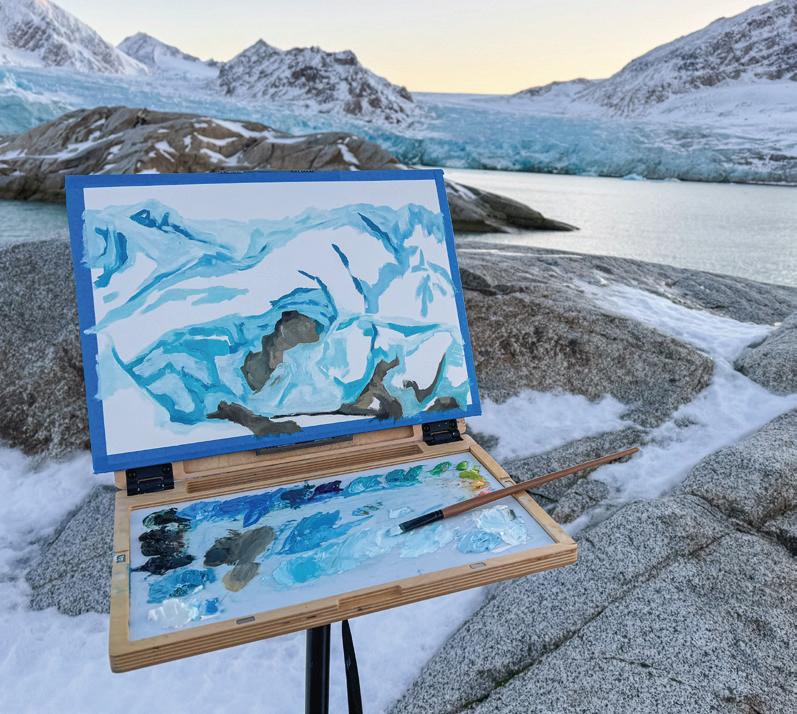
and their environmental impact. Chambers, who typically specializes in painting forests and greenery, created more than 60 oil and gouache pieces. Despite the unique challenges of painting in extremely cold conditions—and potential polar bear encounters—the deep sense of wonder and responsibility she felt in witnessing such a pristine and raw wilderness left her with a profound gratitude and awareness she will never forget.
Her project was based on the idea of field research— painting on-site and documenting the place, time and experience. "It's hard to put into words, and that's why painters are painters: You can't really talk about 'it' or what 'it' is. Translating it through paint helps to convey that meaning."
On the first stop, the artist set up her easel and paints to capture an area where the serene mountains reflected off a calm pool of water. She set her bag down, compiled her paints next to her easel and went to work.
"I was so enamored and just so in awe that I was getting to paint that all of a sudden, I looked down, and I'm standing in about six inches of water," she said, explaining that the tide had come in unnoticed while she was working. "I had to pack up really quickly. It was funny because the water wasn't close when I first went out there."
Leaving behind the familiar comfort of civilization and entering the seemingly limitless expanse of the Arctic Ocean was a profound experience for Chambers, one she still finds hard to convey in words. From her floating studio, free from all distractions of daily life, Chambers experienced the vastness of the sea, a pristine landscape devoid of human interference, and breathtaking colors and shapes.

Left, Chambers stands among huge ice chunks while she paints on St. Jonsfijorden. A UMHB Faculty Development Grant helped with expenses for the trip. Center, because temperatures were below freezing, Chambers placed hand warmers under her palette to keep her paints from hardening so quickly. Right, using oil and cold wax, Chambers creates a painting she titled “Franklinbreanne Glacier 80°N 19° E.”
Describing her paintings as "plein-air painting," which is French for "out-of-doors" or "painting on-site," Chambers and the other artists and scientists got to leave the boat to explore twice each day. While she was painting, the scientists dug through snow and moss to look at microorganisms, videographers recorded the melodic creaking and groaning of the icebergs, and photographers captured the untamed beauty through their lenses.
"I think the impacts of such an experience are so far beyond what I can comprehend at the moment that I don't even know what it will be until it starts to settle, and I can process a little bit more.”
In the high-Arctic, weather can change in the blink of an eye. Since her trip took place just as summer began transitioning to winter, the expedition could sail to the islands without having to break through the thick ice that forms in the winter. Because the area isn't fully mapped, crew members often had to watch from the bow for icebergs and submerged islands. Daily temperatures hovered between 10 and zero degrees Fahrenheit. When the group launched on Oct. 3, they had close to nine hours of daylight each day to explore, but by the time they returned two weeks later, daylight had transitioned to about three hours each day.
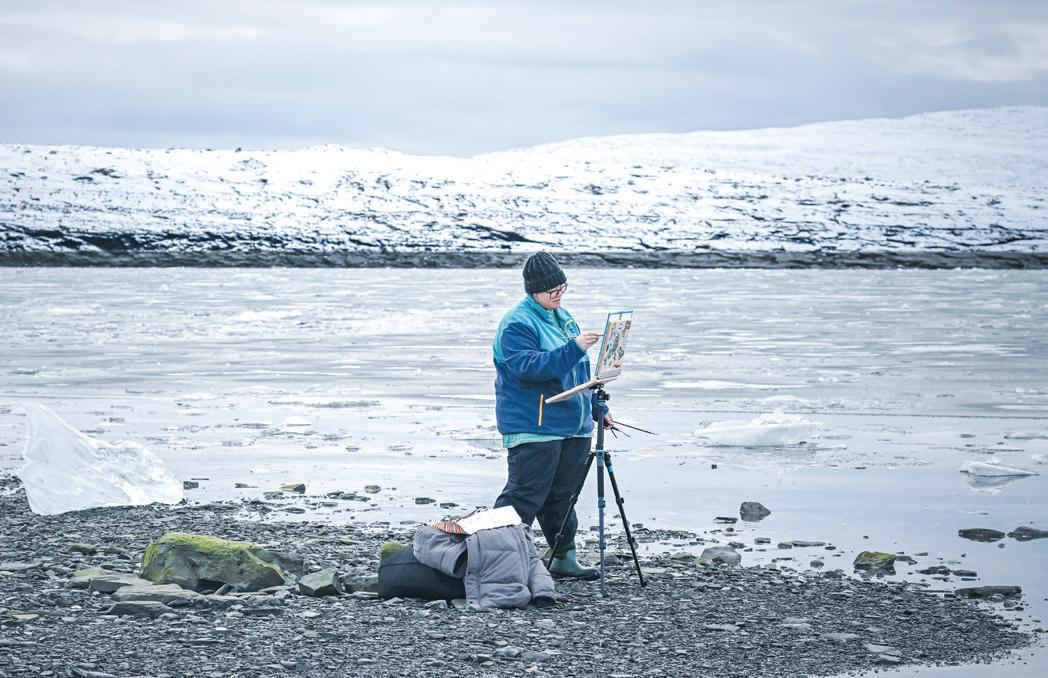

Chambers was one of 30 international artists and scientists selected through the Arctic Circle Program to participate in a two-week residency aboard the tall ship Antiqua (pictured in center) around the high Arctic to study and record the melting glaciers. Right, painted from the deck of the Antiqua, Chambers created this Gouache study while sailing past the Seven Glaciers.
Being in a place where possibly no human had ever walked made Chambers feel both magnificent and special to live on this earth, but also very small at the same time. "It's incomprehensible how it made me feel. I've never felt anything like it and will never feel that way again," she said. "The presence of God is so overwhelmingly strong to be in such a place. The idea of faith is that there's no proof, right? That's why you have faith. But that was proof—there's no way that was created by anything other than God. I feel like if someone was ever questioning their faith and they experienced what I experienced, they would never question their faith for the rest of their lives."
The crew constantly monitored the weather and maps for the semi-charted area to find ideal places to drop anchor. Because glaciers and ice caps have their own mini-weather cycles, the situation could change instantly.
"We might be going up a fjord where the weather should be good, but then you come up to a certain glacier, and it's super windy or snowing. "The group aimed to make two landings each day of the voyage and had to hop on smaller boats called zodiacs that the crew would launch to shuttle them ashore.
While the scientists and artists were prepped during the morning briefings and donned their heavy gear and life jackets, guides boarded the Zodiacs to scout the
exploration zone for polar bears and set up a perimeter to help keep the voyagers safe. They stood guard, always watching and scanning the horizon for the deadly creatures.
"The polar bears were the most significant threat, but other than that, we had free reign to climb and explore as much as we wanted. They gave us a lot of freedom in choosing what we wanted to experience and how we wanted to experience it."
Though the group did spot a polar bear from the boat, they fortunately only saw fresh paw prints while hiking. When one of the guides discovered a sleeping bear on the other side of a hill, she quickly turned the voyagers around and headed back to the landing site. Chambers said they did get fairly close to some walruses on Moffen Island, but the guides kept an eye on them, and they never got aggressive.
Just as a photographer captures a vision through a lens, Chamber says she translates her physical presence in a place through the movement of her marks, the choice of colors, and the way she mixes the colors and puts them on the canvas.
"It all comes from the shape, the energy, the literal kind of energy from my arm moving the paint across the canvas or paper," she explained. “Paintings are influenced more than just visually but also by noise, by temperature, by sound, by smell. The things you are surrounding yourself with all influence how marks are made, how colors are chosen and how they're manipulated and put together on the canvas."
When Chambers sets out to paint, her goal isn't to duplicate what her eye is seeing.


"It's incorporating all of these other energies and experiences to influence the painting and being open to letting the painting develop and respond to the time and the moment."
She said expeditions like this one are important to help preserve the pristine environment of the glaciers at the North Pole.
"The ice there is melting three times faster than anywhere else in the world. The effect of that is major, yet it's so far removed from us that there's no immediate effect. So, people don't have the pull to want to protect it."
The trip was meaningful for her to document and return information to the public to raise awareness and connect with them.
"Even though most people may never get to go there, art helps connect them to it and builds a kind of empathy and a sense to protect it."
Because Chambers lived in Northern Illinois while she worked on her Master of Fine Arts degree, she was familiar with the clothing and layers needed to fend off the cold. But what truly prepared her for the North Pole was the three years she’s been trekking to glaciers in Alaska to paint in temperatures dipping to 20 degrees below freezing. One of her discoveries was placing hand warmers underneath her palette, which kept her oils from hardening so quickly. She also began putting a towel on the ground to insulate her feet from the frozen earth.
"It's taken me years of trial and error to figure out how to paint in the snow!”
Being chosen as one of 30 scientists and artists from around the world was an adventure in itself. The detailed application process included a 15-page proposal, a project description and a letter of support from her dean. Three months later, Chambers learned she was selected to join the Arctic Circle expeditionary residency program. Just to reach the remote launching point, she had to take five connecting planes from Austin to Atlanta to Frankford to Oslo and then to her final destination—a tiny airstrip in the small village of Longyearbyen, on the archipelago of Svalbard.
When the ship returned, the group stayed in the village for a few nights to reacclimate to civilization. "When they put this residency together, they realized the magnitude of what we would experience and that you need a little bit of time to get back to reality.”
Chamber said her experience in the Arctic has definitely impacted her teaching style. In her classroom, she emphasizes the value of field-based research, where students engage in on-site experiences to inform their conceptual and artistic development. She says encouraging students to conduct interviews for art projects and collect data from various sources like museums or local sites can greatly inspire and enhance their artistic messages.
"It's not just finding inspiration on the internet and going to the library. Those things will feed into what you're doing, but there are other options open to you as well. It's about getting them to see what type of message they want to say through the art and then finding different ways to collect information to inspire their choices to create the artwork."
Chambers says that now that she's back from the expedition, she's trying to figure out her responsibility to share what she learned with the world.
"It's still so surreal. I have this now and need to share it somehow, but I'm figuring it out; it will be years of projects, paintings and talks. It was incredible that I got to go to one of the most remote places in the world, and they let me make art from the moment I woke up to the moment I went to sleep. The opportunity to see something like that and then paint it is still mind-blowing."
BY RILEY ZAYAS


As she prepared to retire from the Army, several of her fellow soldiers encouraged her to do just that—run collegiate cross country. She knew she would be going back to school with the intention of earning a degree to coach high school cross country. But running college cross country? That seemed to be a different path entirely than the one she had planned.
But as her retirement date loomed, Drea began to seriously consider the idea, knowing that if she stuck to a training plan and challenged herself, running at the college level as a 20-year military veteran was certainly attainable.
Drea sees running as more than a passion or athletic endeavor. To the UMHB freshman, it's a way to glorify God, and while running, she uses the time to pray and listen to worship music. On a cold January morning, the Lord gave her a clear picture as she ran. She saw herself running with a team—something she hadn't done since high school. Her passion for distance running during her Army service had mostly been an individual endeavor—one that helped her escape some traumatic memories she experienced both at home and abroad. Running provided peace through the chaos—a consistent source of positive exhilaration in what can sometimes be a tumultuous, challenging life in the service of one's country.
Serving as a First Sergeant with 20 years of military service and five combat tours under her belt, Drea Gibson could outrun many of the privates in her company in the U.S. Army. She has run through it all: the hardship of loss, both personal and professional, and the stress of deployments and uncertainty. Military life can be difficult and unforgiving, yet through running, along with her strong faith and family, Drea has become a tenacious and resilient athlete, both necessary characteristics for a great cross-country competitor.
Looking back, Drea admits she wasn't even sure how the process worked or if there were rules about a retired soldier competing in NCAA athletics. But she felt the Lord's pull on her heart and trusted His call. In a conversation with the NCAA, her vision became a reality: “You have full eligibility to run,” they told her.
New to Central Texas, the veteran next looked up cross-country programs, and UMHB rose to the forefront. Despite being a relatively new program in Division III cross country, started by current head coach Alex Aldaco in 2018, the women's team won the 2020 ASC championship and finished 16th at the NCAA West Regionals in 2023. It seemed like the perfect opportunity for Drea to push herself as a runner and integrate herself into the team.
There was still one hurdle to overcome: Drea needed Coach Aldaco's approval to actually walk-on with the program. He hadn't recruited Drea out of high school like the vast majority of his freshmen runners and had never seen her run.
"This was an unusual situation, so I had my doubts," Aldaco recalled. "I asked to meet with Drea to get a sense of what she wanted to accomplish and see if it was even possible to adapt my training principles to her situation.”
When they met, Aldaco said he was impressed with her solid endurance background and her motivation to coach young athletes one day. Any hesitancy the coach had seemed to fade when she told him her current times, which were on par with what he was looking for in his high school recruits.
Talk with Drea for even a short time and you'll see how important her faith is in her life. It's evident through the joy she exudes when thinking back on her wild journey, which took many twists and turns, including a fall that temporarily paralyzed her when she was in elementary school.
In high school, the unthinkable tragedy of the 9/11 terrorist attacks rattled the U.S. to its core. "I made the decision, even before my senior year started, that I was going to serve my country," she says.
And Drea did so valiantly, earning a Combat Action Badge and several other honors over the two decades she served. She went on combat tours to Iraq twice, Afghanistan twice, and Ukraine once, seeing things that put the pressures of running and day-to-day life into perspective. Thinking back on all that she went through is an emotional experience for her, but she also recognizes the power of the Lord to have gotten her through it all. "I feel like I'm walking in a thousand of His blessings.
There is something to be said for how the Lord has worked in my life. Because I know, having lived it, there is no logical or reasonable explanation that I am able to run today. I can't tell you how many rockets missed me. I can't tell you how many bullets flew past me. And I'm still here. It doesn't make sense. I know it doesn't make sense to me. And I don't expect other people to understand it. But I know because He's given me so many chances to keep living, the only explanation is that I'm running for Him. When I run, I feel like He's with me."
As much as she hopes this experience makes her a better runner, she is well aware of the value of being part of a team before she actually coaches one of her own, which is her ultimate goal. It's that passion for helping others achieve their own personal records and dreams that has driven Drea's desire to be the best coach she possibly can be, and her time running at UMHB is only aiding in that.
Her freshman season was one of both milestones and setbacks. Drea suffered an injury early on but was undeterred. She rehabbed as the fall went on, remaining dedicated and connected with her teammates, even though her training plan looked different.
"The initial plan was for her not to run the rest of the season, but she was working so hard in her rehab, and I think the team was impressed by her dedication."
She eventually worked her way back into the lineup, running at the American Southwest Conference Championships and the NCAA D-III West Regionals. At the conference championships, UMHB claimed its second title since the program's restart in 2018.
Fittingly, Drea earned the ASC's Newcomer of the Year award. She didn't expect the award, but her dedication, passion and contributions to UMHB's program were unquestioned throughout her first season in the program.
"Despite the challenges I faced this year, I know the Lord was with me at each turn," Drea said. "I give Him all the credit for allowing me to run and finish the race. I'm so grateful for my team and Coach Aldaco. And I look forward to returning next year, a little bit wiser and stronger."


Jerry Cephus still remembers sitting on those bleachers, watching the action play out on the field, and like any kid, he wanted to be a part of it. The fourth-grader had watched the team of elementary school football players for three days now. Nobody had seemed to notice him. That was, until a man, evidently one of the team’s coaches, walked towards the bleachers and gave him an offer that Jerry could not turn down.
“Would you like to play with us?” Cory Stricklin asked.
“I didn’t second guess it at all,” Jerry, a senior wide receiver for the Cru, remembers. “I said, ‘Yes’, and went out there. They had me at safety, and
on the very first play, I intercepted the quarterback. It was pretty awesome.”
Stricklin remembers that day especially well too. He saw early on that Jerry possessed a feel for the sport. But looking back, neither Jerry nor Stricklin knew what that humble offer, and Jerry’s acceptance, would lead to down the road.
Jerry has been a star in the Central Texas area for eight years now, having made his name on the gridiron and basketball court of Academy High School, where he doubled as the starting quarterback of a playoff football team and starting shooting guard on a basketball team that reached the state semifinals his senior year. His list of accolades is remarkable, including District MVP honors in football and multiple all-district honors in both football and basketball. But what seems to be noted most about Jerry is his pure work ethic and effort.
“He was our scout team receiver that was always in my huddle,” UMHB head coach Larry Harmon said of Jerry as a freshman in 2021. “So even though I was only the defensive coordinator, I got to see Jerry every day. Jerry has a lot of ability, a lot of talent, and he made our defensive backs better because of the effort he gave.”
That “talent,” an all-encompassing word that only partially captures Jerry’s agility, speed, and overall football IQ, was an attribute Stricklin saw early on in Jerry. At first, he was put at defensive back and made a few plays. Once he tried offense, things seemed to click even more. And he had a smile on his face.
“I said, ‘Why don’t you come down here and we’ll see what you got,’” Stricklin recalls of his first conversation with the now 5’10, 180-pound receiver who has played in 27 games at UMHB since 2022.
“UMHB was close to home, and it felt like home.”
— Jerry Cephus
Stricklin put him on offense, and he made some great plays, so he offered him a spot on the team. “Let’s go talk to your parents,” Stricklin said.
“Well if it costs money, I can’t do it,” the fourth-grader responded.
“Well, don’t worry about that. Let’s just go talk to them,” Stricklin replied.
The short drive to his home was one that would change the lives of Stricklin, Jerry, and Stricklin’s son, Brock, who quickly became one of Jerry’s closest friends, on and off the field.
“We got in the truck and drove over to where he was living, and the conditions weren’t ideal,” Stricklin said. “So Jerry ended up going home with us that night, and he’s been with us every day since, for the last 12 years.”
Jerry has not wanted to leave. In fact, the proximity to his family in Academy played a significant role in his decision to continue his collegiate career with the Cru.
“UMHB was close to home,” Jerry said of his college decision, “and it felt like home.”
He has been a Crusader for four years now, and a reliable target downfield for UMHB’s quarterbacks over the last three seasons. His varsity debut, on a night in which The Cru’s 2021 Stagg Bowl team was honored, saw Jerry make four catches for 77 yards and a touchdown on Sept. 3, 2022, against Muhlenberg.
“It’s no surprise the kind of game he had,” Harmon said of Jerry after the win. “We know who he is. And that’s why he’s on varsity. To be in our top seven at wide receiver is really saying something.”
Jerry backed that up in the performances that followed. He finished his sophomore year with 13 receptions for 148 yards and in each of the last two seasons, has recorded over 250 receiving yards. During the 2024 regular season, he led UMHB’s balanced receiving corps with 19 catches for 363 yards, including a 102-yard performance on Senior Day against Howard Payne.
Considering the fact that Jerry has only been a full-time receiver since the spring of 2022 and the significance of his quick start—and subsequent success in the years that have followed—makes his success that much more notable. He came to UMHB as a quarterback, but even through his success under center for the junior varsity squad in 2021, the coaching staff already saw his potential as a pass-catcher. So when the coaches spoke with him on the first day of spring workouts about a position switch, Jerry was all ears.
“Playing receiver on the scout team [came about because] we had a lot of quarterbacks,” Jerry said. “I was like, ‘I’ll go help them somewhere else.’ I ran full speed, and it kind of came naturally to me.”
He also noted the level of trust in the coaching staff and their ability to put each player in the best position to help both the team and the individual succeed.
“You don’t meet many coaches like Coach Harmon,” Jerry added. “He genuinely cares about you. You can see that he’s passionate about everything he does. If he asks you to do something, you will do it, without thinking twice. If he asks me to play receiver, I’ll do it. If he asked me to play kicker, I’d go do it. It’s really about the trust we have in Coach Harmon.”
But he did not make the transition on his own. New UMHB receivers coach Jeremy Harness played a pivotal role in Jerry’s development, as did Brock, who is the inspiration behind why Jerry wears No. 11 for the Cru.
“I had been struggling with blocking,” Jerry said in the fall of 2022, during his first season as a full-time receiver. “[Brock] texted me about it and helped me with playing receiver, because that was his position.”
March 22, 2019, is another day in Jerry’s life that he will never forget. Brock had begun experiencing painful headaches that would not go away. Doctors found that the headaches were the symptom of a serious brain tumor.
“We took him in, and the doctor looked at his eyes for seconds before saying, ‘We’ve got to get him an MRI,’” Stricklin remembers. “She made it happen that day, and 16 hours later, we were in emergency surgery, removing the tumor. When they came in to tell us he had the
continued on page 31
When freshman Yazmin Hernandez packed up and moved to Belton to attend UMHB, it was one of only a handful of times she had left her hometown deep in the Rio Grande Valley. Born in McAllen and growing up in nearby Donna, Texas, her whole world revolved around a 20-mile radius. Her very tight-knit family and all her high school friends were Hispanic and spoke Spanish, or "Spanglish," as she calls it, which is a hybrid of Spanish and English. The farthest she'd ventured from her home was a trip once to Dallas, but that was the entirety of her explorations outside the Valley.
When she moved onto campus last fall, the biology, pre-vet major says it was a "culture shock" because things were so different than where she grew up. She suddenly felt very alone.
"It was very abnormal for me to be away from my family," said Yazmin, who is also the first in her family to go to college. "It was hard saying 'bye' because we're very close and connected."
During Move-In Day, she met Rebeka Retta '90, the assistant director in the Kingdom Diversity Office, who invited her to swing by her office sometime to talk. When Yazmin went for a visit, she learned something that comforted her and gave her assurance she'd made the right decision in choosing UMHB. Retta shared with Yazmin that one out of every four students on campus self-identify as Hispanic or Latino, and more than 40 percent come from minority populations, including international students from 23 countries from as far away as Azerbaijan, China and Brazil.

This past fall, the Department of Education designated UMHB as a Hispanic-Serving Institution (HSI), a milestone indicating the institution has reached 25 percent Hispanic enrollment. The designation provides students with programs and initiatives annually and allows universities to compete for national grants.
Even though Dr. Sanfrená Britt '20, director of the Kingdom Diversity Office, is thrilled that UMHB has the HSI title, she said that knowledge is more valuable than the designation "because we now know that we need to understand this population because it's growing, and we need to know how to support them."
The best way to do that is to talk to them, she said.
"Listening to them and understanding the things that are important to them, and then finding a way to make sure we're incorporating those things within our culture so that the university itself feels like home. It feels like I'm being embraced into this community, and I belong here."
Averianna Featherston, Stephanie Jenkins and Hailey Ruiz hang out at Luther Memorial to enjoy a sunny day of studying.
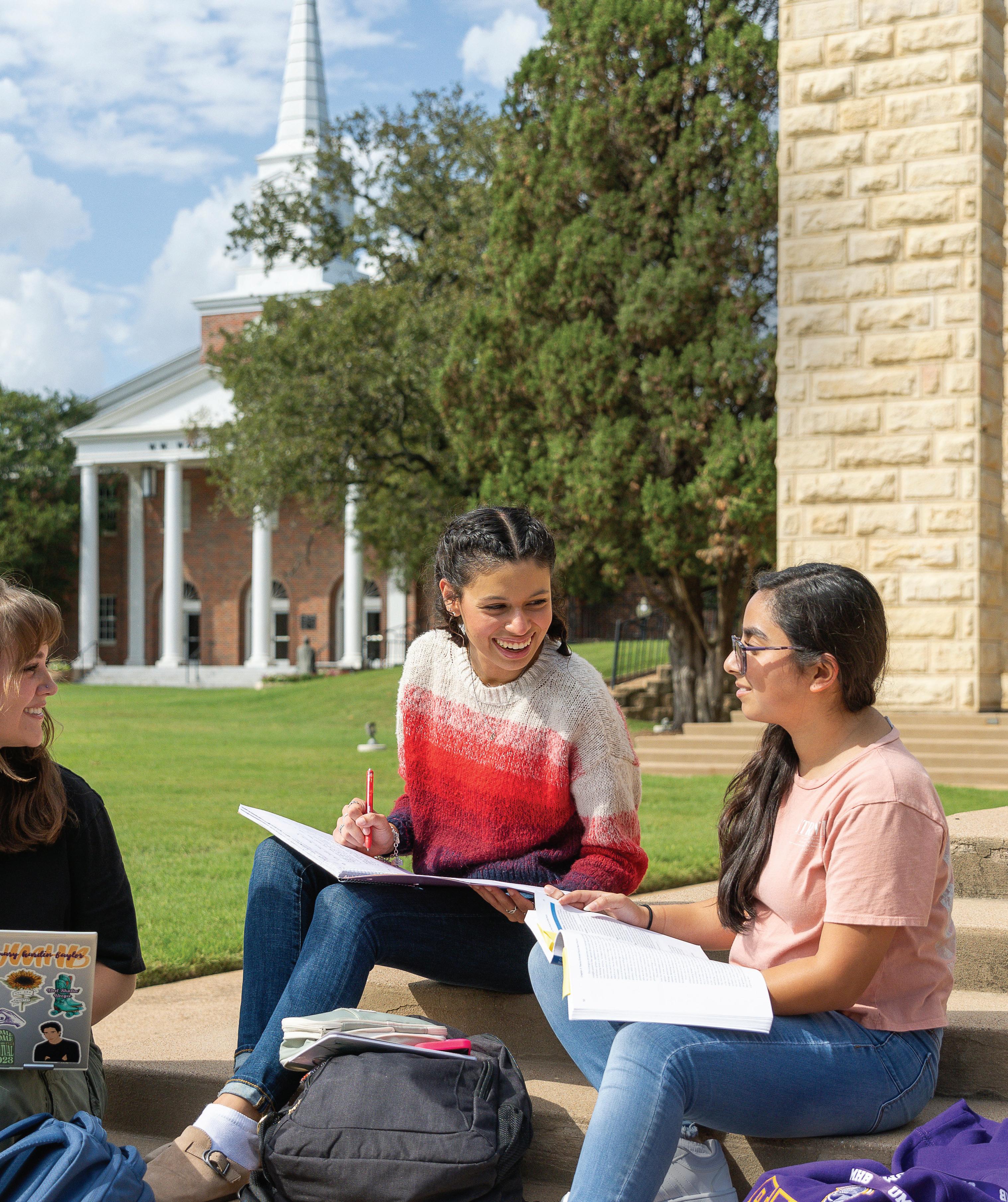
BY CHRISTI MAYS
Two years ago, the Kingdom Diversity Office was established to embrace and enhance the university's culture by creating a "culture of belonging," as described in Genesis 1:27: "So God created mankind in His own image, in the image of God He created them; male and female, He created them."
Britt stresses that the office focuses on creating a feeling of belonging and home for all students and less on being treated as a minority group. Every student should feel as though they have ownership. "So the conversation shifts from you being 'invited to the table' to 'this is your table.' I have free reign to be a part of anything that happens in this space because I belong here," she said. "So that's the conversation we should be having, not from the owner's perspective, but from the shared space."
When Retta arrived as a student at UMHB in 1987, she said she was one of only about seven Hispanic students on campus.
"I can't say I never felt at home because I adapted to what was here, because I loved being here," she said. And she wants every student to have that same feeling and experience from day one. "We want them to experience that when they move in on Move-In Day and during Welcome Week. We want them to see that there are a lot of people of color here and want them to feel at home. I know why I stayed, and I want other people to feel that too."
Britt added that feeling a "sense of belonging" helps retain students until graduation.
"If I feel like I belong here, it's not as easy for me to walk away once I've made connections and friends. I have a reason for being here other than academics."
Britt says some students come in and adapt because they feel like that's the appropriate thing to do and the only thing they can do.
"But what if they felt safe enough just to be who they are, knowing that their culture and who they are would be celebrated, embraced and accepted? What if they felt as if they don't have to contort themselves into a box that we've pre-labeled and decided this is the box that you check to say that this is who you are, and all of who you are is in this box, and this box now has to fit within our
community? What if the box didn't exist, and we celebrated our differences but embraced who we were as children of God? What if that was the focus where I didn't feel as though I needed to adapt? I could just be who I am and still feel loved?"
Besides creating new cultural events and activities, one of the initiatives of the Kingdom Diversity Office is to perform research to enhance the experiences of minority groups on campus.
After approval from the UMHB Institutional Review Board, Britt and Retta recently conducted a focus group with eight students who identify as Hispanic and Latino to talk about their experiences on campus, things that are important to them and their wishes for the future of campus. With their findings, they plan to create a publication to share with other universities, specifically those that are HSI campuses or those that aspire to be HSI campuses.
Even though the focus group was official business, every day in the Kingdom Diversity Office is like an unofficial focus group because Britt and Retta are always available to listen to students.
"They know that we're not going to judge. We just want to hear so they see what they've talked about manifest. I think that's more important because they often say things and believe nothing will happen— they're not expecting anything to happen. But when they do see it come to pass, it blows their minds."
When Yazmin walked into Retta's office to chat that first afternoon, she was thrilled to hear Retta's ideas about how she could get involved in clubs like the Hispanic Student Association. While visiting Retta, she also met Irma, who knows people from the Valley. The two hit it off immediately, talking in "Spanglish."
"It felt comfortable. It felt nice getting to meet new people," Yazmin said. "That was a good day for me.
"Finding out that there is a bigger Hispanic community that I had no idea about was just very motivational, and it kept me going knowing that there are others around me going through the same things I'm going through."
Since that first week when Yazmin moved into an unfamiliar environment, UMHB has begun to feel more like home as she's meeting and making new His-
panic friends and friends from all over the state, country and world.
"I think it's good finding other people from other cultures and connecting with them on a different level that most might not understand," she said. "Here at UMHB, I'm not just closed in my own culture. I get to see new things and how other people live in other cultures. So, it's definitely forced me to get out of my comfort zone."
The conversation shifts from being ‘invited to the table’ to ‘this is your table.’ I have free reign to be a part of anything that happens in this space because I belong here.” - Dr. Sanfrená Britt, director of Kingdom Diversity
Left, Rebeka Retta '90, the assistant director in the Kingdom Diversity Office, loves talking to students and listening to their ideas about how to make UMHB the best university. Right, Hispanic student Yazmin Hernandez of Donna, Texas, was happy to learn that UMHB is designated as a Hispanic-Serving Institution (HSI).
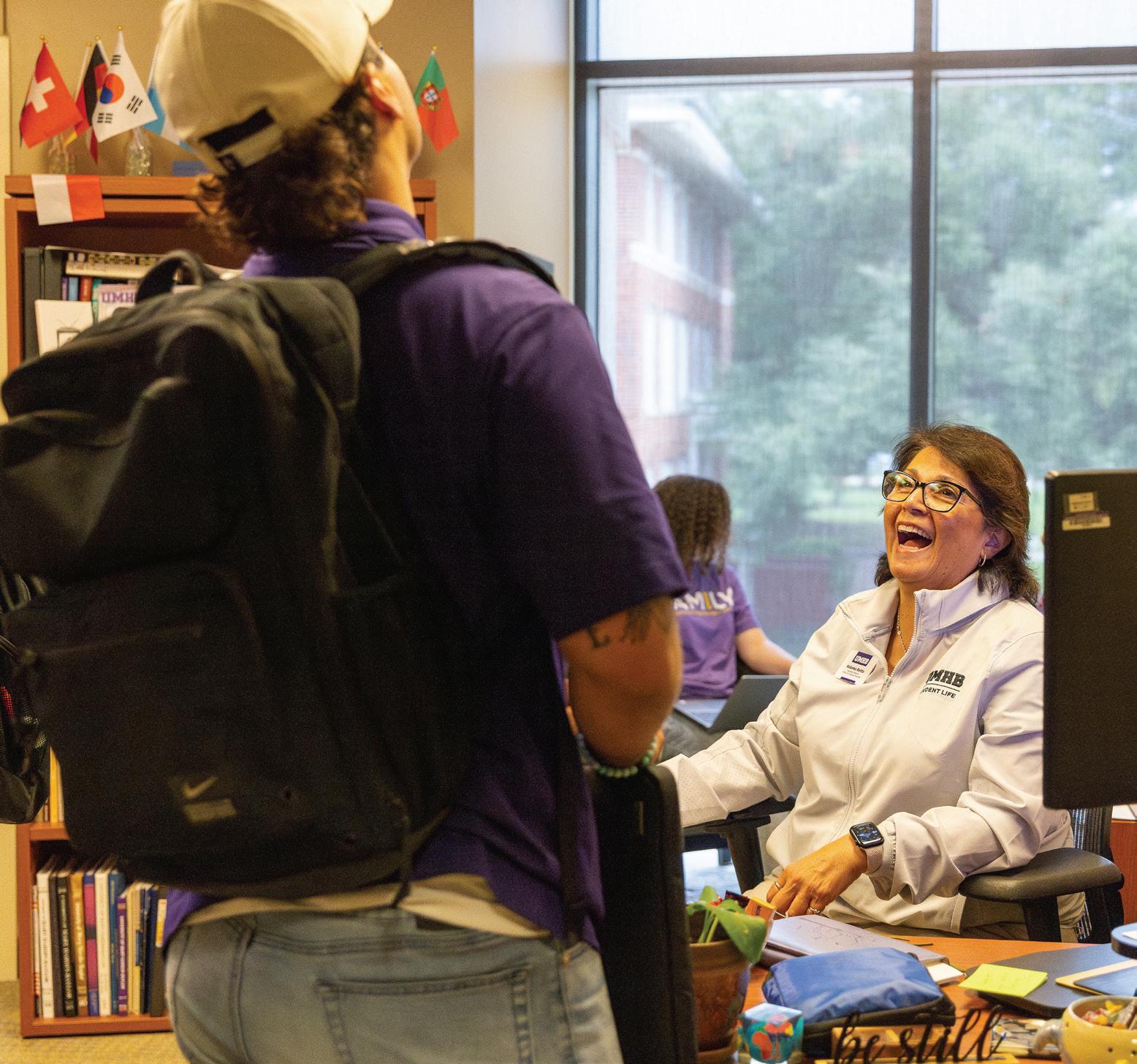

Adjusting to college life is no joke, especially when it comes to the roller coaster of emotions that students often experience when leaving for school. For many students, it's their first time being away from family and friends, and venturing into an unknown world can leave them with a severe case of homesickness as they long for the comforts of home.
Though there are many ways students can focus on conquering the daily blues, the biggest key is time

(and maybe an unexplained discovery).
Students Samantha Ellington and Mia Hanks felt all the highs and lows when they left home for college, but their serendipitous discoveries of two timeless treasures helped ease their sadness through connections to the past.
When she moved into Remschel Hall last fall, Samantha Ellington didn't realize how much she'd miss her mom's cooking, her siblings' chatter and even her dad's "silly dad jokes."
"I miss that feeling of being in a house where something's always going on," the freshman marketing major said.
But every time she opens the door to her room, a comforting reminder of the love and support of her family back home greets her—the handmade patchwork quilt her grandmother made many moons ago for her
TIMELESS TREASURE
Freshman Samantha Ellington lays on the same quilt her mother, Sheri Ellington ’97, had in her room at Burt.

BY CHRISTI MAYS
mother, Sheri Johnson Ellington '97.
The quilt was a prized possession her mom passed down to her a couple of years back and had adorned Samantha's bed while she was in high school. When it came time to discuss décor for her dorm room, instead of opting for something new, much to her mother's surprise, Samantha told her she wanted to take the quilt.
"It's cute," she told her mom, and it took one more thing off her to-do list before moving to UMHB, where her mom graduated in 1997 and her father, Ben, attended from 1994-95. Just before moving to campus, Samantha asked if her mom had photos of her time in Burt and Remschel halls. The two began digging through some old photo albums and soon discovered a photo that shocked them. There was the quilt spread over Sheri's bed in Burt Hall! Sheri knew she had the quilt during her childhood but had no recollection of taking it to college, and now, that same quilt adorns her daughter's bed in Remschel.
"I can't walk into my room and not think of my family
and my mom," Samantha said. "I really love constantly coming into my room and being reminded of them. It's very comforting. It feels like home."
Growing up in a military family, Samantha said she was used to moving around, but for years, she had her heart set on attending UMHB, no matter where her family lived. Then, one day, one of her schoolteachers told Samantha's class not to choose a college just because it's where their parents attended. Samantha made a point to check out potential colleges while living in Kentucky and California. "They just didn't feel right," she said. "So, I would pray about it, and I just didn't think I was supposed to stay there. I always knew Texas as my home, so I started looking there."
Knowing she wanted a smaller campus and a Christian atmosphere, she knew Texas had plenty of options.
"I took a tour here at UMHB, and immediately when I stepped onto campus, I had this unexplainable feeling of peace. I asked the Lord if this was where
He wanted me to go and again felt this great sense of peace. I definitely felt called to come here, and I haven't felt any shakiness in that decision. He always has a plan for me, and He has provided it time and again."
It just so happened that Samantha's family was moving to San Antonio, and she is only a two-and-ahalf-hour drive away from them and can visit often. But what about students like Mia Hanks, who move to UMHB from another state or even country? As the oldest sibling of four, her family's approach to choosing a college came down to the school willing to give the most scholarship money. With only two schools—UMHB and Union University in Jackson—left in the running, Mia and her family were hanging out at
the beach in the fall before she left for college, and she remembers crying to her mother.
"I did not want to go to Union at all, but I had competed for a scholarship package there and won a large sum of money. I was just so torn up about it and remember telling my mom, 'I just feel like my people are at UMHB.'"
During that very conversation, Mia received an email from Hershall Seals, the Art Department Chair in the UMHB fine arts department at the time, offering her an art scholarship she couldn't refuse. She was thrilled to be headed to UMHB, where both her parents, Shawn and Heather (Price) Hanks, graduated.
"Now, I know, never to tell the Lord anything. He knows better!" she said.
With her family back in Tennessee, Mia, now a senior studio art major, suffered from intense homesickness her first semester.
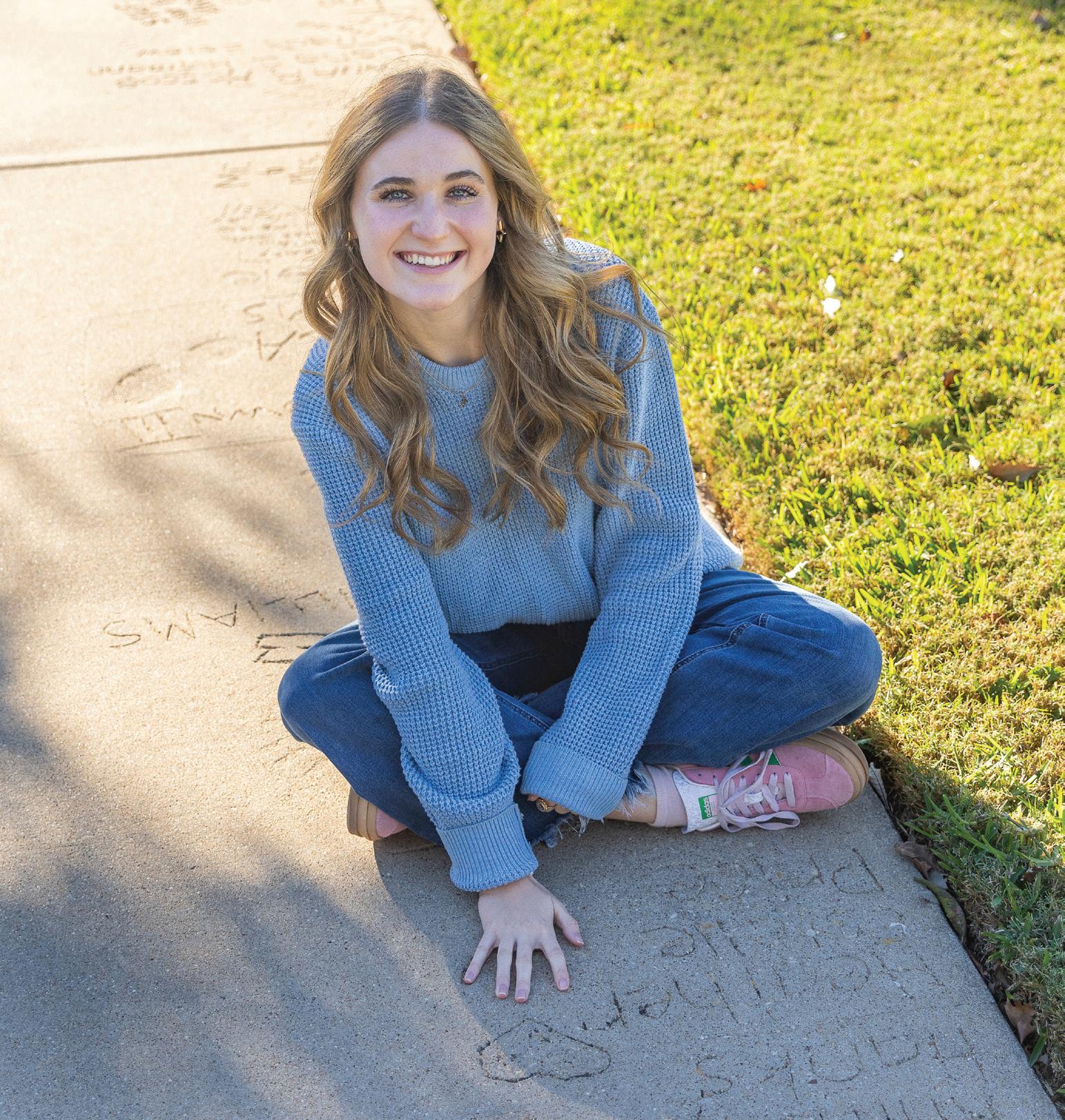
Senior Mia Hanks’ hand is the perfect fit for her mom’s handprint. During her freshman year, Mia spotted the print, along with her parents’ names, Shawn and Heather (Price) Hanks, written in the concrete sidewalk between Burt Hall and Hardy Hall.
"I was homeschooled my whole life, and I had never been away from my siblings, and it was a very jarring change to be suddenly 800 miles away from my family." Thankfully, her parents planned to visit during Family Weekend, which was just a few weeks into the semester, but to Mia, it felt like a lifetime.
"That first semester of freshman year felt like it took eight years to go by," said Mia. "I was so emotional and homesick my first semester. It was so hard!"
Predictably, as many students do after a few weeks of being away, Mia recalls a phone call she made back home: "Mom, I want to come home! This is so hard!"
But her mom knew she would tough it out.
One day, while walking the sidewalk between her room at Burt Hall and Hardy Hall, Mia started reading the names of students who had left their names in the cement years ago for a fundraiser. She recognized one of them as a buddy of her parents and wondered if her mom and dad had also left their names. A moment later, she spotted their names and a handprint her mother had left. Mia knelt and placed her hand over the palm
print, and it was an exact match. The moment was surreal. "They were here, and they experienced what I'm experiencing," she said. "It was a cool moment to realize I was going to be fine. If they could do it, I could too!"
Each semester that Mia spent on campus, and after each Christmas and summer break, leaving home and being away from family progressively got easier, Mia said. This is typical as time passes and students begin settling in, establishing routines, finding new friends, and getting involved, said Karen DuBroc, director of UMHB Student Counseling Services.
Often, when students go to college, they don't always know how to define what they're feeling as homesickness, and it's not uncommon for the counseling center to begin seeing students who need a little boost of confidence after the first few weeks of school.
"They may come in feeling less like themselves, down, isolated, lonely and wondering if they made a mistake by choosing to go to school here, but having a difficult time even knowing why they may feel this way," she said. "This typically slows down by the second semester, although if a student has a great home life and enjoys being with their family, this can come and go throughout college.
These feelings are pretty manageable, however. As students become aware of their feelings and then take action to get out of that slump, they get through it with much greater ease.
Though there are many ups and downs a new student will face, which can feel like a roller-coaster ride at times, thankfully, this ride has some predictability, says DuBroc.
"Showing them the W Curve Model helps normalize what they may be experiencing," she said. "They realize the rationale of their feelings and feel validated by naming it; students already start feeling better. It helps tremendously when they realize that homesickness will likely pass if they keep taking steps to connect with others most of all."
In addition to showing students the W Curve Model, Dubroc and her team also walk them through these ideas to help them overcome the stages of homesickness.
Be flexible and try new things. This will vary from person to person, but sitting with one of UMHB's counselors allows them to get practical ideas that appeal specifically to them, as well as anything that might stand in the way of this effort.
Get involved in the things that you already like. This can be difficult to think through and put into action when one is feeling down, as it can be demotivating and overwhelming, especially if students aren't sure what UMHB has to offer for their interests. Thankfully, we have a wide spectrum of clubs, recreational activities, and sports on campus that interest most students!
Do not expect to adjust overnight. Going to college is an adjustment on every level, and we must have some patience with ourselves. Also, there is no magic pill, and like many forms of hardship, we have to be willing to take action and do the work required to adjust.
Process your thoughts and feelings. This is the specialty of our counselors! We love to walk alongside students and remind them they are not alone, and we encourage our students to examine their thoughts and feelings with someone who cares to really listen. Stuffing one's feelings is never healthy, and finding a safe and confidential person to talk them through with is one of the best steps a person can take.
Use the resources available to help you handle the stress. Plenty of resources on campus are available to our students at no additional cost! Thankfully, our university is also located in a fantastic town with churches, college ministries and other opportunities for students to engage. Staff and faculty here at UMHB love to connect students with many of those resources.
INTERPROFESSIONAL PRACTICE
Doctor of Physical Therapy student Garrett Draper helps a “pretend” patient during a real-life scenario to learn how to work side-by-side with other professionals.
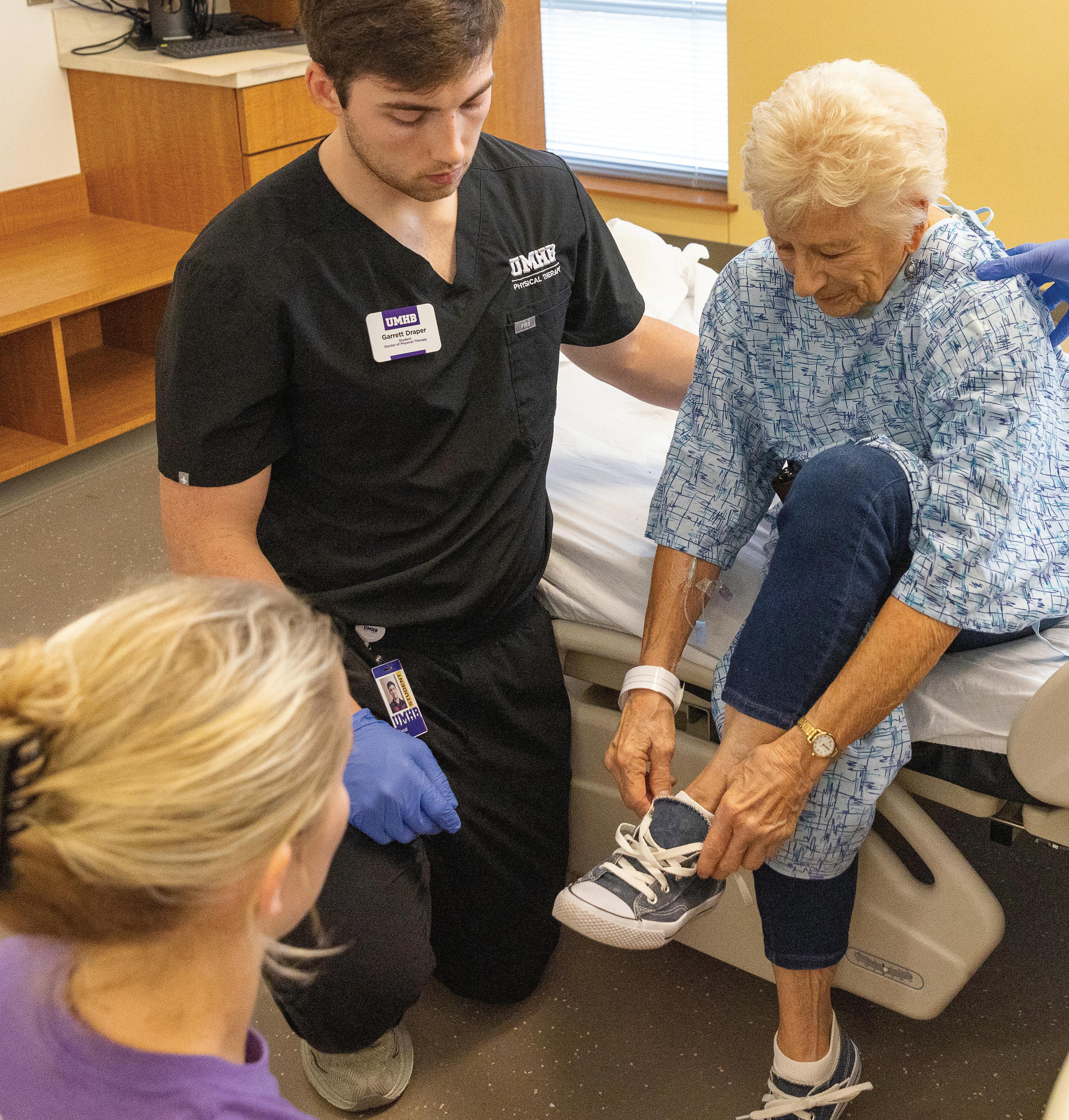
BY CHRISTI MAYS
When junior social work major Averianna Featherston walked into the exam room, the first red flag she spotted was the bruises on her patient's face. Looking at his chart, she realized this was his fifth visit to the emergency room in a month. The patient was "very soft-spoken and sweet," and Averianna quickly sensed he didn't want to upset his wife, who was derogatory and rude to him. Whenever Averianna and her colleagues asked him a question, the wife interrupted and talked over him, dismissing his bruises with convenient explanations.
Averianna knew all the indications pointed to domestic abuse, and she and her colleagues, an occupational therapist and physical therapist, proceeded to consult with each other about the best course of action, which they decided involved separating the spouses to consult with them individually and getting Adult Protective Services involved.
The scenario was one of three interprofessional education simulations (IEPs) on elder abuse, dementia and poverty that UMHB health education students recently participated in to learn how to collaborate effectively to help improve patient outcomes.
"Even though it was just a scenario, it was hard seeing that because it reminds me that this actually does
happen, and those will be real cases that we will have to deal with when we graduate," Averianna said. "Overall, the whole process was very rewarding, though, because we got to go through a step-by-step process of what would happen. It all happened so quickly, but that's how it will be in real-life situations."
The simulations included students in nursing, physician's assistant, physical therapy, occupational therapy, counseling and social work. None of the experiences are required for licensing, but they are a university requirement for graduation and part of UMHB's health professions accreditation.
"No matter which health profession route you choose, it is all interprofessional practice," said Dr. Tracy Booth, director of interprofessional education for the Mayborn College of Health Sciences. "In the real world, we all have to work together as a team to provide care for our patients. So interprofessional education provides opportunities for students to learn from and with each other to prepare them for interprofessional practice."
Because everyone uses healthcare, Booth says healthcare providers must learn to collaborate to determine the best action plan.
"In terms of nursing, I can't do nursing without some physicians or PAs or advanced practice nurses, and the

same goes for them. No one of us can do it all, so we have to work together and know everybody's roles and responsibilities so that we know who we can count on to help us with whatever else we need to do."
The scenarios include moulage, which is a special-effects makeup used to simulate injuries, aging and other physical characteristics, and all the props necessary to bring the simulations to life, explained Simulation Specialist Rebecca Sharpe, who helps dream up the scenarios.
"I want to make sure that it's as realistic as possible. And so I put on the makeup. I put on the knee brace and the ID bands and make sure that the equipment that they need is in the rooms."
While Averianna was dealing with the abusive wife,
another scenario included a relative who was stealing his mother's pain medication, leaving his dying mother in pain. Another scene involved a home health check in which an Army veteran with a total knee replacement was discovered living in squalor because he was unable to take care of himself and had no support system.
Sharpe said UMHB students are blessed to have the Learning Simulation Center to practice these scenarios that happen in real life every day. She encourages them to see the center as a "safe place" where mistakes can happen and where they can learn from them and help prevent them from happening in the real world with an actual patient.
"I tell the students: 'When you go into the clinical

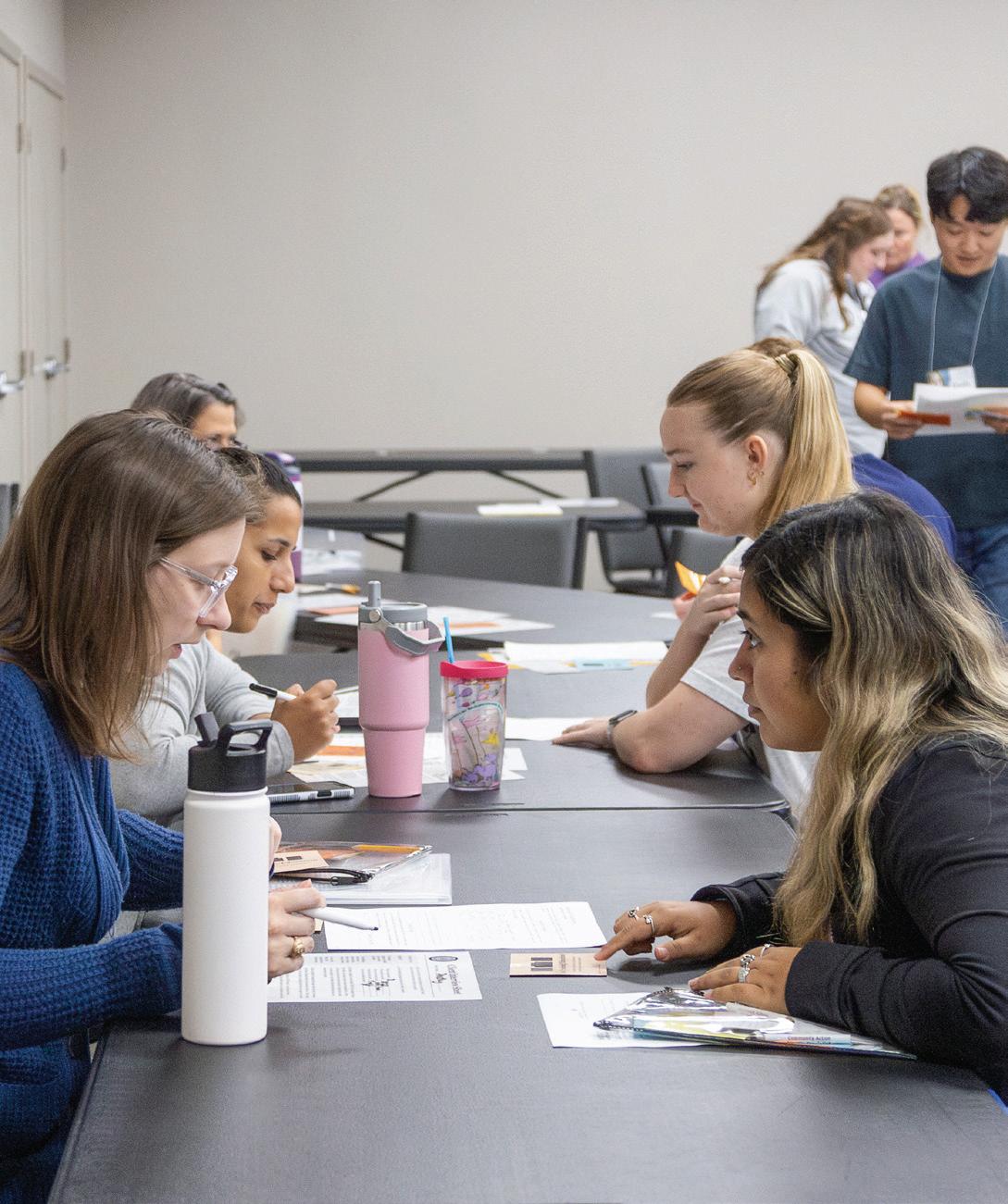
Opposite, junior social work major Averianna Featherston and her colleagues talk with a pretend patient during real-life scenarios to teach students how to work well with other professions. Above, students work together in a poverty simulation to learn how to find the best solutions and resources for families.
setting to do orientation or rotations, you are a student nurse or OT or PT student. You are no longer the student when you walk into the simulated hospital. You are the nurse. You are the PT, the OT, and I want you to own that role so that you can show us what you know—show us what you're going to do when you are by yourself, and you don't have your faculty holding your hand. Then, we can see what you're going to do and just help get you better.'"
Creating IEP scenarios came to fruition about three years ago, and Sharpe said it has been amazing to see the various professions work together.
"Debriefing is always my favorite part," she said. "Getting to hear from the students who have taken part in the scenario, saying, 'Wow, I didn't think about it this way,' or, 'We did it this way, and that was such a
great way to do it.' They realize how they can work as a team together and better understand what each of these different professions can do to help them in theirs. That's what IEP is all about."
Averianna, who studies social work because she wants to advocate for people with disabilities, says the simulations have broadened her perspective on the different, real-life struggles people have.
"It's been good to see different areas of advocacy that I didn't ever put much thought into before, and how I would have to solve or help with or give recommendations of resources families can use if they're struggling with different issues," she said. "The simulations were really interesting — kind of scary, a little bit, but also very rewarding and very eye-opening."
Barbara Austin ’07 uses her background in design to combine creative art with Bible study, which she shares with others on her website, www. divinecreativelove.com.

BARBARA AUSTIN
‘07
Alumna uses her love of crafting to draw closer to God's word
When Barbara Austin graduated in 2007 with a degree in computer graphics design, she knew she liked creative means of expression, but she had no idea how her artistic abilities would become a part of her faith journey. Now, almost 18 years later, Barbara finds herself using creativity and scripture to share her Bible journaling abilities on her platform, Divine Creative Love.
“Around 2015, I started seeing photos of other people’s Bible journaling pages on Pinterest and Instagram, and I was very intrigued,” Barbara said. “At that time, Bible study was not a priority in my life, and although I knew God’s word was alive and active, it was hard to see that for myself just reading it.” Barbara knew she had to try it, and when she received a journaling Bible for Christmas in 2015, her journaling journey was born.
Bible journaling is the creative process of writing, drawing and illustrating God’s word in an interactive and reflective way. This activity is not a one-size-fits-all model of spiritual reflection and oftentimes looks different from person to person. For Barbara, Bible journaling opened doors to a deeper connection with God's word and spiritual community.
“I would watch video tutorials from a Bible journaling teacher I found online, and then attempt to do those things in my new journaling Bible. At first, it was
terrifying! I was so afraid to mess up the Bible page. But then, I realized it was making God’s word come alive for me—kind of like seeing the Scriptures in 3D, where they were previously only in 2D. I wasn’t just reading and forgetting anymore, I had notes and artwork I could refer back to and a visual in my mind to remember the scriptures. Bible journaling unlocked a new ability for me to understand and connect the dots of scripture, and it continues to do so today!”
Barbara soon wanted to share her new love and found a way to connect with others. She repurposed a blog she had already started and began teaching others. A few years later, as the pandemic hit and many people were stuck at home, Barbara felt God calling her to share video Bible journaling tutorials on YouTube.
“Considering that I learned Bible journaling from watching someone else’s videos, I think of this as paying it forward to help more people discover the Bible study benefits of journaling.”
When not teaching her journaling techniques, Barbara can be found crafting handmade cards and vinyl designs for tee shirts for her online store and pouring Biblical wisdom and encouragement into her online weekly newsletter subscribers.
Barbara says her time at UMHB played a role in her Bible journaling and walk of faith.
“I owe a lot of my faith journey to the wonderful classmates, faculty
and staff I encountered during my time at UMHB. When I entered as a freshman, I was Christian in name only. I had grown up in Sunday school, and even gotten confirmed in the church, but I could only see it as religion. But, thanks to many wonderful people and testimonies that I encountered at UMHB, I began to realize that I was missing something. Or more specifically, someone,” she said. “My new peers spoke about Jesus like He was their best friend, and I was so intrigued. It took me another two years to sort out my beliefs and come to terms with the fact that I am indeed a sinner in need of saving. But once I did, Jesus truly did set me free!”
While Bible journaling has taken on a business-like form through her blog, Austin still sees it as a spiritual practice.
“I am a very visual person, so Bible journaling just helps me better understand and connect with Scripture than reading or writing alone. It has fueled my faith in many ways. It increases and re-ignites my thirst for God’s word, helps me refer back to relevant scriptures when I need those reminders, and overall just unlocks the message of God’s word in a tangible way.”
To learn more about Barbara’s Bible journaling and connect to her network, visit her online at www. divinecreativelove.com or on social media, @divinecreativelove.
— By Lauren Spears '24
Betty L. Builta '53
September 10, 2024
Glenna M. Stamps '53
September 15, 2024
Christene Westbrook '53
October 12, 2024
Myrtle R. Veach EX '56
April 12, 2024
1960 s
Frances M. Birtchet '64
March 19, 2024
Sandra E. Browne EX '64
September 20, 2024
Morris S. Tyson EX '64
October 2, 2024
Jean Smith '66
May 21, 2024
Patricia L. Jones '68
August 31, 2024
Karon E. O'Brien '68
July 24, 2024

UMHB profoundly mourns the loss of our alumni, faculty, staff, students and retirees. We express our deepest sympathy to their family and friends, and honor each of them here.

Betty Sue (Craven) Beebe '61
January 10, 2025
A 1961 graduate of MHB, Betty Sue began a 36 -year career at the university in 1981. She received the Distinguished Alumni Award from the UMHB Alumni Association, and retired in 2017. Betty Sue's contributions to the alumni and advancement offices are immeasurable. She will be missed by her UMHB family.
1970 s
Hannah B. Ngwa '70
May 30, 2024
Milford L. Cagle '73
October 8, 2024
Tilman J. Prater '73
March 13, 2024
Christine L. Steffy '74
September 4, 2024
Sue B. Lemons '75
April 15, 2024
Frank E. Pajestka '76
October 1, 2024
Nancy V. Stalmach '79
August 10, 2024
1980 s
Peter H. Chen '85
August 2, 2024
Darlene Neiser '85
August 5, 2024
William R. Case EX '87
March 6, 2024
Margaret E. Fox '88
August 13, 2024
Marilyn J. Hurley '89
September 7, 2024
1990 s
Lelani R. Clark '90
September 9, 2024
Marvie R. Gaines '96
October 6, 2024
Ralph Garcia '99
August 6, 2024
2000 s
Maria D. Berumen '01
August 2, 2024
July 9, 2024 - November 4, 2024
Tommy and Margie Bennett
Linda Breaux
Linda Black
Walt and Pam Manly
Randy and Julie Wheeler O’Rear
Steve and Grace Coulter
Theodore
Mickey Burleson
Jane Potter
Janice Muehlstein Caldwell
George and Mary Marusak
Dr. Peter Chen
Amy Bawcom
Jerry and Vicky Bawcom
Ron and Debbie Brown
Billy and Glenda Truax Moore
Rebecca O’Banion
Randy and Julie Wheeler O’Rear
Riley and Carolyn Allison Owens
Chuck and Jennifer Ramm
Marshall and Penny Renfro
Steve and Grace Coulter Theodore
Shirley Cherry
Marjorie Shackelford
Jennifer Caldwell-Dulgher
Jerry Caldwell
Luanne Gantt
George and Mary Marusak
Margaret “Pollye” Eddleman
Mark and Betty O’Hair Anderson
Joey Garner
Ken and Melba Garner Hobbs
Bobby “Buzz” Harrington
Jerry Caldwell
Robert and Edie Cornett King
Anita Dusek Hoelscher
Peggy Bass Albin
Dr. and Mrs. A.A. Hyden
Thomas Dannelley, Jr.
Betty Kemp
Coleman and Donnette Street
Rush Leigh
Tucker and Karli Ralston Glaske
Rebecca O’Banion
Jane Potter
Dr. Amy LeVesconte
Chung and Ruby Yung Lam
Edna O’Banion
Mark and Betty O’Hair Anderson
Jerry and Vicky Bawcom
Kelly and Mindy Boggs
Ron and Debbie Brown
Jerry Caldwell
Terri Covington
Jim and Teresa Edler Crothers
Henry and Cheryl Garza
Tucker and Karli Ralston Glaske
Shawn and Heather Price Hanks
Larry and Linda Hilliard
James and Susan Kamas
Walt and Pam Manly
Jeff and Rochelle Emeigh Miller
Trey and Amy Wright Moore
Randy and Julie Wheeler O’Rear
Brad Phillips
Chuck and Jennifer Ramm
Jimmie and Janey Roush
Joel and Erin Young Shoemake
Gerry and Janie Suthoff
Elizabeth Wheeler Tanaka
Steve and Grace Coulter Theodore
Janice Torgeson
Dillard and Karolyn Norwine Whitis
Randy and Kim Kittredge Yandell
Keith and Barbara Young
Dr. Ron Owens
Ron and Debbie Brown
Daniel and Marcy Mynatt
Rebecca O’Banion
Randy and Julie Wheeler O’Rear
Kyle and Robin Payne
Chuck and Jennifer Ramm
Steve and Grace Coulter Theodore
Frank Pajestka
Darius Moore
Riley and Carolyn Allison Owens
Mary Nell Moore Pirtle
Ron and Debbie Brown
Debbie Potts
John and Ellen Agan
Mark and Betty O’Hair Anderson
Dick and Kay Smith Archer
Dudley and Vivian Baker
Barge Foundation
George Bartels
Amy Bawcom
Jerry and Vicky Bawcom
Belton Legend Oaks Property Owners
Ron and Debbie Brown
Carol Burr
Chuck and Candy Button
Madelon Carroll
Louis and Charlynn Casey
Central and Title Company
Cliff House Council of Co-Owners
Barry and Judy Couch
Terri Covington
James Cure
Thomas Dannelley, Jr.
Jana Deakins
Andrew Hanen and Diane Dillard
Don Ringler Chevrolet
Rodney Dunn
Thomas and Daryl Edwards
Stephen and Mary Ellis
Extraco Banks
Ted and Kathy Floca
Renee Fuller
Gerry and Patti Gamble
Wilson and Nancy Garner
Becky Garth
David and Susan Gaskins
Joe George
Tucker and Karli Ralston Glaske
Clarence Griggs
Donald and Jan Grobowsky
Staci Haudek
Pat and Elayne Kaufman
Christine Kianes
Jim and Laurie Kiniry
Ken and Marlena Kjelland
Jim and Karen Lane
Sam and Karen Listi
Griff and Kathy Lord
George and Susan Luck
Jeff and Jeannie Ludwick
Ludwick, Montgomery and Stapp, PC
Randy and Tammy McKee
Bill and Ann Messer
John Messer
Amy Mitchell
Monteith Abstract & Title Co., Inc.
George and Patricia Ivey Moore
Michael and Jane Moore
Becky Muse
Larry and Lynn Neal
Glynda Neuwirth
Helen Pickle Normand
Rebecca O’Banion
Randy and Julie Wheeler O’Rear
Linda Ozanne
Jane Potter
Pete, Gloria and Michael Ramos
Susie Ratliff
Eugene and Diane Ring
Mary Robinson
Brenda Stovall Rogers
Salado Creek Antiques
Ray and Brenda Severn
Jack and Rosemary Sims
Cindy Spencer
State Bar of Texas
William and Lynda Stokes
Suzanne Stubblefield
Tarver and Blythe Law Firm
Steve and Grace Coulter Theodore
Michael and Tammy Thompson
Dennis and Ann Turk
Brad and Kerri Turner
Brent and Allison Warren Turner
Frank and Marilyn Turner
Ken and Debbie Von Gonten
George and Nancy Vorpahl
Carol Walton
Robert and Kay Watson
David and Connie Weeks
James and Andrea Weinblatt
Charlotte Wheeler
Blair and Mary Jane Williams
Bobby and Patty Potts Wilson
Ronald and Nancy Payne Wright
Terri Zeleskey
Catherine Rock
Jennifer Rock
Betty Jo Bounds Sanders
Ron and Debbie Brown
Jay Frank Schultz
Andrew and Kendra Smith
Glenna Morgan Stamps
Shirley Barfield Cockerham
Patricia Lockridge Shannon
Barbara Jean Valley
Darius Moore
Kathy Owens
Kent Owens
Riley and Carolyn Allison Owens
Jimmy Wheeler
Jerry and Vicky Bawcom
Dave and Sue Benson
Dr. Aaron Baggett
Todd and Kelly Kunders
Rico Conde
Kristi Geishauser
Bill Euler
Jude Stahmer
Joan Sanders Harrington
Robert and Edie Cornett King
Mac Hickerson
Links Bible Study
Dr. Kim Newton-Hunter
Todd and Kelly Kunders
Mr. Larry Locke
Todd and Kelly Kunders
Reed O’Rear
Dennis and Lyndal Cabaniss
Marietta Parker
Mark and Betty O’Hair Anderson
The Potts Family
Andrew Hanen and Diane Dillard
Ron and Debbie Brown
Dennis and Lyndal Cabaniss
Terri Covington
Alan and Shari Cox
Don Ringler Chevrolet
Ted and Kathy Floca
Cliffa Foster
Tucker and Karli Ralston Glaske
Jimmy and Carol Hudson
Bobby and Donna Bolick Johnson
Griff and Kathy Lord
Walt and Pam Manly
Drayton and Elizabeth McLane, Jr.
Bill and Ann Messer
Paul and Jane Meyer Family Foundation
George and Patricia Ivey Moore
Joseph and Ruth Ann Murphy
Rebecca O’Banion
Randy and Julie Wheeler O’Rear
Jane Potter
Chuck and Jennifer Ramm
Diane Simpson
Keith and Tonya Spears
Steve and Grace Coulter Theodore
Philip and Kim Thornton
Janice Torgeson
UMHB Faculty Council
Joan Foster Yost
Kathleen Kruse

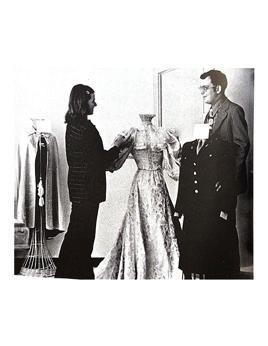



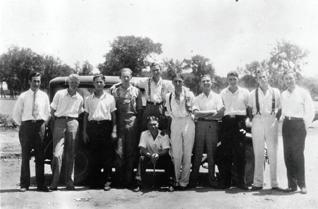


One More Rep! | UMHB Amazing Athletes continued from page 13
tumor, they told us to say our goodbyes because he wouldn’t make it.”
Jerry still gets emotional thinking back to when he heard that news. Since Jerry had come to live with them, he and Brock had developed an incredible bond, pushing each other to improve and being each other’s biggest supporter. It was Jerry who threw Brock the first touchdown of his high school career.
“They went to the hospital without me, because I was still in class,” Jerry recalls. “It came out of nowhere. We had no idea that was a problem. They texted me, and I went right to the hospital to be with him. That was one of the scariest things for me and my dad.”
“Jerry was naturally gifted, but at a young age, didn’t have much drive at all,” Stricklin recalls. “And Brock had all the drive. Early–morning workouts, to midday workouts, to evenings, and this was even before junior high. He just loved the game so much. It motivated Jerry.”
And just as Brock had continued to exceed expectations as he and Jerry made their marks on the gridiron, he overcame a hurdle the doctors thought was impossible.
“I didn’t come this far to only come this far,” Brock told them. “I’ll make it out of surgery. I’ll be back.”
He did just that, and more, on the road to recovery. A year of rehab followed, and during each session, the therapist would ask him to do 10 reps of various exercises or movements. But Brock refused to do 10. Instead, he did 11, because as he said, ‘That’s one day sooner that I get to go home.’”
“It inspired me,” Jerry said. “To see him get up and work as he could when he had the odds against him. To keep doing one extra rep every time inspired me to work harder in everything I do. Whenever I take the field, I know I’m going to go as hard as I can every snap because that’s exactly what he would do.”
Watching that hard-nosed mentality play out in addition to his versatile skill set, it is surprising to think that in ninth grade, Jerry considered quitting football altogether. It wasn’t because he didn’t love the sport anymore. He did. But as an all-round athlete with his skill set, basketball was calling, and it seemed he might have more potential on the court than the field.
“I actually was going to quit football my ninth-grade year,” Jerry remembers. “I stuck it out and chose the football route. But basketball definitely was a thought at first.”
“To see him get up and work as he could when he had the odds against him, to keep going one extra rep every time, inspired me to work harder in everything I do.”
— Jerry Cephus
Thankfully for UMHB, he stuck with football. But his prowess on the court continued through high school, as he helped lead Academy to a perfect 12-0 district record, the 3A Region III Championship, and a trip to the state semifinals.
“That was like a movie,” Jerry said of the incredible season. “That team was a family. We bonded together. That was one of my favorite experiences ever in high school. We really played for each other.”
A similar feeling came over him during his time at UMHB. Like his time at Academy, Jerry has been part of plenty of winning during his three seasons as a starting receiver. In the 2024 season alone, UMHB picked up a monumental win at UW-Whitewater in Week 3. And after dropping two regular-season matchups to conference rival Hardin-Simmons in the regular season, Jerry and the Crusaders got the better of the Cowboys in the second round of the Division III playoffs. With the 17-13 win in Abilene, the Cru booked its trip to the third round for the third time in the last four years.
But it’s also the chemistry that will stick with him long after he hangs up his cleats. He is part of the tradition, embraces the Code of the Cru, and relishes what it means to put on the purple and gold each Saturday.
The impact this program had on him, as a person just as much as an athlete, is not lost on him.
“The feeling of playing on this team is amazing,” Jerry said. “The people you meet, the guys you encounter; it’s an amazing feeling.”

A fallen Vietnam War hero was recognized in a special presentation during the annual UMHB Military Appreciation football game on Nov. 16, and an endowed presidential scholarship to help future military leaders was unveiled in his name.
The SSG Felix M. Conde-Falcon & Lydia Conde Medal of Honor Endowed Scholarship was created to honor the war hero who served as a staff sergeant with the U.S. Army's 82nd Airborne Division during the Vietnam War.
In the ultimate sacrifice, CondeFalcon distinguished himself through valorous actions on April 4, 1969, when he led an assault on enemy bunkers, single-handedly destroying three enemy positions before being shot and killed.
For his valor, he was initially awarded the Distinguished Service Cross but, in a review by Congress, was upgraded to the Medal of Honor. On behalf of his father, Richard "Rico" Conde accepted the Medal of Honor from President Barack Obama at the White House on March 18, 2014.
Rico, his sister, Jeannie, and their family were grateful that their father had been recognized 40 years after his death, but they wanted to do something special with the medal besides placing it on a bookshelf to collect dust.
"We wanted his legacy to continue to live," said Rico, who was three years old when his father was killed. "It is phenomenal that God brought my family and UMHB together, and this event was a testament to that and evidence of His work in our lives. God is great!"
After Rico was invited to speak at the American Legion during a Memorial Day celebration, he learned about the ROTC program at UMHB. With the help of several Veterans of Foreign Wars groups and the local Military Officers Association of America, a plan was set in motion to donate the medal to UMHB to display in the ROTC department and to create the scholarship in his father's name to assist incoming ROTC students with tuition. The selection process for the inaugural scholarship recipient will begin in the spring of 2025.
"Now with this scholarship endowment, my dad's legacy is going to be tied to the Medal of Honor for a long, long time, and also to a great university and the young leaders of our country moving forward," said Rico, who lives in Academy. "We're excited to know that this is something that, after we're all long gone, will continue to give back to the young leaders of our military."
In just a little over a year since fundraising efforts began, the endowment has already grown to more than $120,000.
Prior to the Military Appreciation game halftime announcement, Rico said he had attended a couple of football games at UMHB over the years, but that was the extent of his relationship with the university, even though he has lived and worked in the area for close to 40 years.
"There's so much more depth to the university. The campus is beautiful, but I found out it's the people within the campus that make UMHB what it is."
To donate to the scholarship, call 254-295-4173

On his first mission trip with UMHB, Andrew Bezner and his team of 10 UMHB students and staff traveled to a remote village in Nepal where 100 percent of the residents were Buddhist. While there, they shared the Gospel with a man who was studying to become a Buddhist monk. He and his sister-in-law ended up placing their faith in Jesus and were baptized that same day.
The experience was one of the most amazing things Andrew said he’s ever witnessed and knows it will help him in his future.
“Since I want to go into ministry as my vocation, I think this experience will help me reach a lot of people because I feel more confident and see the urgency in sharing the story of Jesus with others in a way that I hadn’t before,” said the junior Christian ministry major.
Andrew admitted that he originally had no desire to go, but God urged Tiffany Horton, director of UMHB Global Outreach, to reach out to
him about going on the trip with his roommate, Braley, who had already committed.
“God used both of them to bring me on the trip, and it was the best decision I’ve ever made,” Andrew said. After last year’s trip, he is already planning to go to Nepal again on this summer’s trip.
Andrew, who was selected as the student leader for last year’s trip, says he gained a lot of leadership experience, learning how to take people’s opinions or situations into account when making decisions.
Even though some of the team members got sick while visiting the village, postponing their plans to travel to their next location, he said the team continued to see God work during the delay.
“Trusting in God was a big part of this, and I leaned on Him more than I ever had. Because of that, I saw God move in ways that I could have never imagined.”
TEACHING THE 'HAND GOSPEL'
Junior Christian ministry major Andrew Bezner (in the yellow shirt) and Rylee Hubbard to his left, teach a group of Nepalese the “hand gospel”—a simple way to explain the Gospel to someone who has never heard it before.
Last year, UMHB GLOBAL OUTREACH OFFERED
6
summer mission trips and medical mission trips.
In the NEPAL TRIP alone, the Gospel was shared more than 200 times IN BELIZE, more than 150 patients were seen in the pop-up clinics and home visits and health education was offered at multiple schools in the area.
with two baptisms and a church plant.
One group took 100-plus beds from Remschel Hall and delivered them to families in the Rio Grande Valley.
GO also took students on 8 TRIPS during the winter break.
